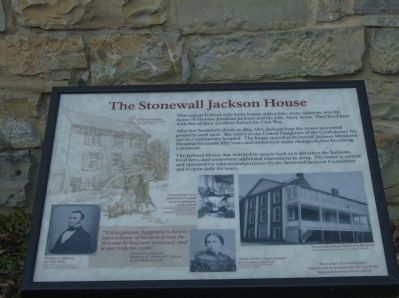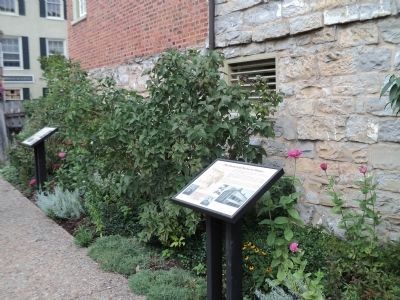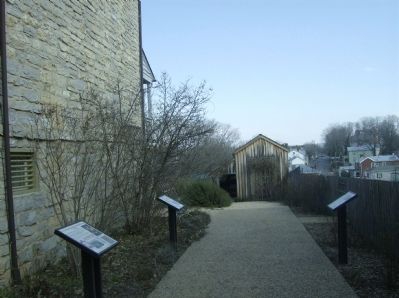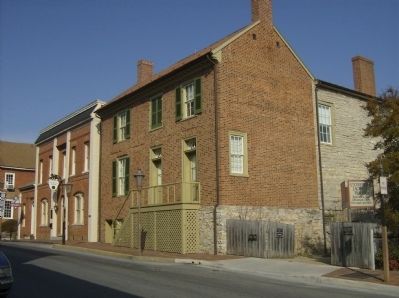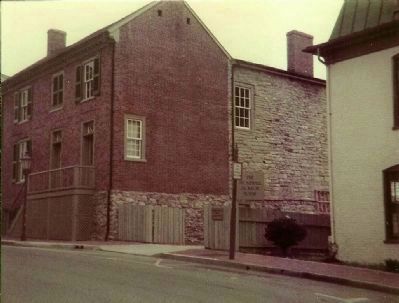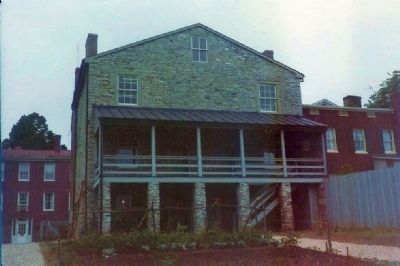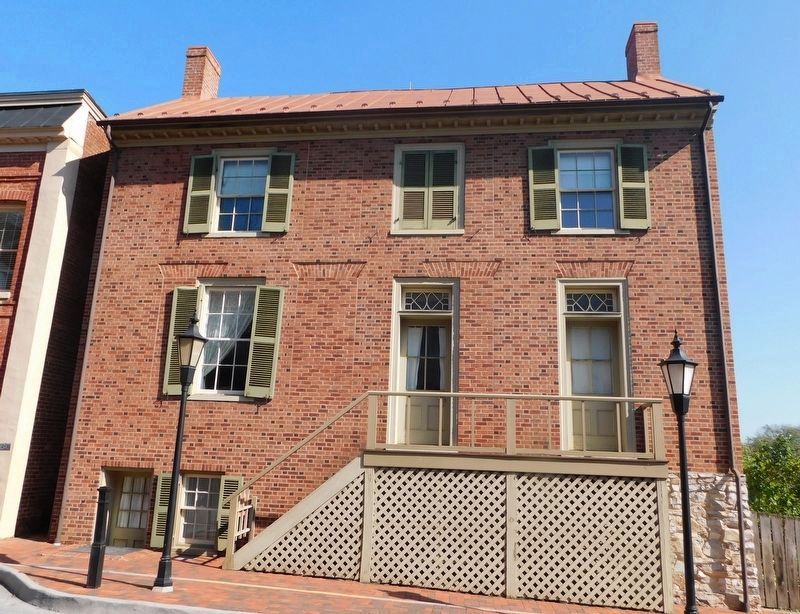Lexington, Virginia — The American South (Mid-Atlantic)
The Stonewall Jackson House
This typical Federal-style town house, with a later stone addition, was the home of Thomas Jonathan Jackson and his wife, Mary Anna. They lived here with five of their six slaves before the Civil War.
After her husband’s death in 1863, Mrs. Jackson kept the house as a rental property until 1906. She sold it to the United Daughters of the Confederacy for use as a community hospital. The house served as Stonewall Jackson Memorial Hospital for nearly fifty years and underwent many changes before becoming a museum.
The Jackson house was restored in 1979 to look as it did when the Jacksons lived here, and underwent additional renovations in 2004. The house is owned and operated for educational purposes by the Stonewall Jackson Foundation and is open daily for tours.
“It was genuine happiness to him to have a home of his own: it as the first one he had ever possessed, and it was truly his castle.”
Mary Anna Jackson, Memoirs of “Stonewall” Jackson by his Widow, p. 106
Topics and series. This historical marker is listed in these topic lists: African Americans • Architecture • Science & Medicine • War, US Civil. In addition, it is included in the United Daughters of the Confederacy series list. A significant historical year for this entry is 1863.
Location. 37° 47.107′ N, 79° 26.476′ W. Marker is in Lexington, Virginia. Marker is on East Washington Street, on the right when traveling west. This is the second of three markers at the Stonewall Jackson House. Touch for map. Marker is at or near this postal address: 8 East Washington Street, Lexington VA 24450, United States of America. Touch for directions.
Other nearby markers. At least 8 other markers are within walking distance of this marker. Lt. Gen. Thomas Jonathan “Stonewall” Jackson 1824-1863 (here, next to this marker); Jackson's Garden (here, next to this marker); Rockaway (here, next to this marker); Dr. Ephraim McDowell (within shouting distance of this marker); Gen. George S. Patton (within shouting distance of this marker); Gen. John Lejeune (within shouting distance of this marker); Frank Padget (within shouting distance of this marker); Little Sorrel (within shouting distance of this marker). Touch for a list and map of all markers in Lexington.
More about this marker. The background image on the marker is the Jackson Dwelling from the Stonewall Jackson Foundation, Lexington, Virginia. The marker also has a watermark background image replicating the Cedar Floral wallpaper, reproduced by Scalamandre for use in the Stonewall Jackson House parlor.
On the lower left is an early photo Thomas J. Jackson by H.B. Hull. (NPG 77.57, National Portrait Gallery, Smithsonian Institution).
Next to the Mary Jackson quote is a photo of by by J. Gurney and Son, courtesy of the Stonewall Jackson Foundation, Lexington, Virginia.
On the right is a photo of house as Stonewall Jackson Memorial Hospital, from the Stonewall Jackson Foundation, Lexington, Virginia. In the center is another photo of the house when used as a hospital showing a patient on the porch.
Related markers. Click here for a list of markers that are related to this marker. To better understand the relationship, study each marker in the order shown.
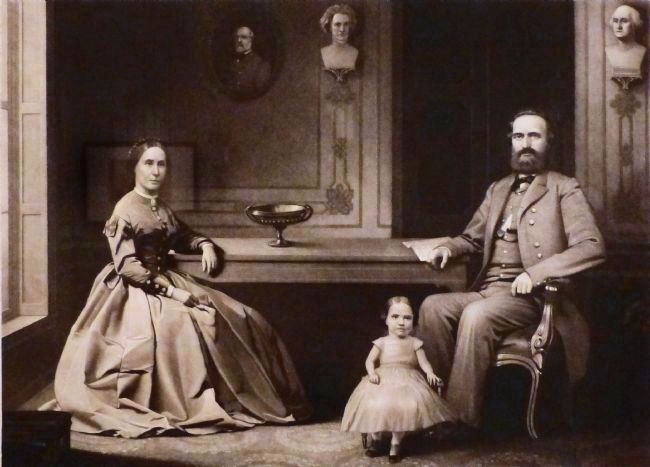
Photographed By Allen C. Browne, February 16, 2015
5. Lieut. Gen. Thomas J. Jackson and His Family
This 1866 engraving of the Jackson family by William Sartain hangs in the National Portrait Gallery in Washington,
DC.
“Southern nationalism is symbolically infused in this engraving of General ‘Stonewall’ Jackson seated with his wife, Anna, and their daughter, Julia. Prominently displayed on the back wall is a portrait of Robert E. Lee and sculpture busts of John C. Calhoun and George Washington. Lee emerged from the war as the South's premier icon; he relied heavily on Jackson's military prowess and leadership up until his lieutenant's death in 1863. Calhoun was perhaps the South's foremost pillar of states' rights and the doctrine of secession, while Washington was held in the highest esteem by both sides as a revolutionary patriot and defender of the Constitution.” — National Portrait Gallery
“Southern nationalism is symbolically infused in this engraving of General ‘Stonewall’ Jackson seated with his wife, Anna, and their daughter, Julia. Prominently displayed on the back wall is a portrait of Robert E. Lee and sculpture busts of John C. Calhoun and George Washington. Lee emerged from the war as the South's premier icon; he relied heavily on Jackson's military prowess and leadership up until his lieutenant's death in 1863. Calhoun was perhaps the South's foremost pillar of states' rights and the doctrine of secession, while Washington was held in the highest esteem by both sides as a revolutionary patriot and defender of the Constitution.” — National Portrait Gallery
Credits. This page was last revised on December 27, 2023. It was originally submitted on January 26, 2009, by Robert H. Moore, II of Winchester, Virginia. This page has been viewed 2,313 times since then and 25 times this year. Photos: 1. submitted on January 26, 2009, by Robert H. Moore, II of Winchester, Virginia. 2. submitted on August 21, 2012, by Bill Coughlin of Woodland Park, New Jersey. 3, 4. submitted on January 26, 2009, by Robert H. Moore, II of Winchester, Virginia. 5. submitted on May 8, 2015, by Allen C. Browne of Silver Spring, Maryland. 6, 7. submitted on January 27, 2009, by Mike Stroud of Bluffton, South Carolina. 8. submitted on January 31, 2021, by Bradley Owen of Morgantown, West Virginia. • Craig Swain was the editor who published this page.
